Cycling New Zealand’s Stunning Southern Alps circuit
From Christchurch to the Alps to Ocean Trail and Wanaka
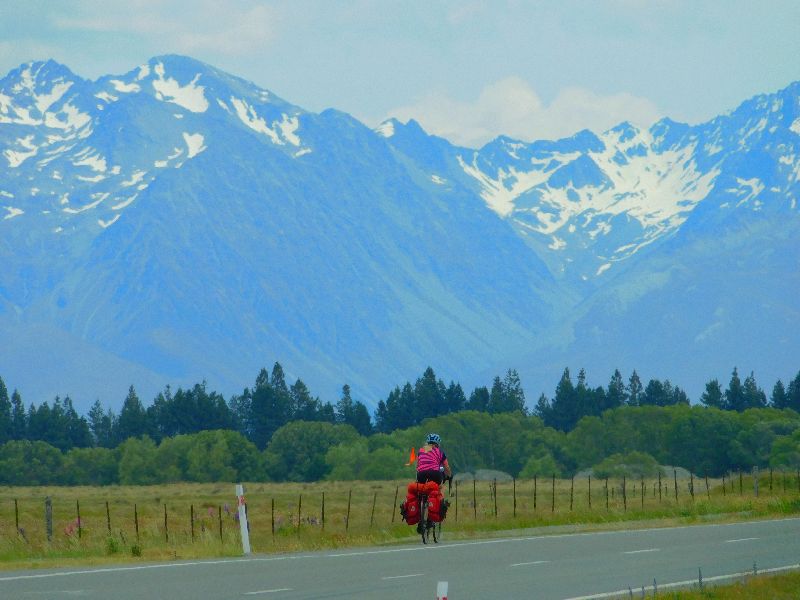
Majestic 12,000′ snow-capped mountains. Towering glaciers. Glistening, turquoise alpine lakes. High plateau grasslands lined with brilliant purple lupins. And wild, verdant coastal temperate rainforests. New Zealand’s Southern Alps Circuit is awe inspiring and jaw droppingly beautiful. It is easily one of the most stunning bike tours we have ever taken in our lives.
But beware! Before you grab your bike, tent and panniers and pedal off into the alpine sunset, be prepared to pedal hard for every magnificent view, every wild mountain campsite, every edible calorie you can find to eat.
Our cycling adventures began seemingly easily enough, in flat-as-a-pancake Christchurch. Mistakenly, we decided to pedal directly southwest along the flat, featureless, agricultural Canterbury plains to Geraldine, assuming it would be a quick, simple way to get our bike legs in shape before climbing up and over the 10,000 – 12,000′ high alpine spine that runs straight down the South Island of New Zealand. After three days of battling grit in our eyes and howling 20-30 miles per hour of wind, stalling us almost to a standstill; horrendous non-stop traffic on the one and only straight road south; and several failed attempts to bypass the highway by cycling on slippery, loose, large-gravel roads, we were delighted to start climbing out of the valley into the mountains. As every cyclist quickly learns, New Zealand’s South Island is permanently windy. Close to Antarctica, it is considered part of the ‘roaring 40s and 50s’ characterized by constant, intense, predominantly westerly winds.

It was not all misery. As Lorenz reminds me, there was one redeeming feature of our plains pedaling ordeals. Airplane museums! New Zealand is obsessed with airplanes and helicopters, which are used daily to transport locals and tourists alike into and (often rescue them) out of remote, backcountry places. Within our first few days on the road, my equally plane-obsessed husband had to stop at the Air Force Museum of New Zealand in Christchurch. Then barely 100 kilometers later, we ducked out of the gale force winds into the Ashburton Aviation Museum. Lorenz oohed and aahed over the museums’ collections of rare aircraft, including a World War II Spitfire and a P51 Mustang. Then, grinning with delight, he grabbed my arm to show me the first two German glider planes he had even learned to fly: the KA-4 Roehnlarche and Bergfalcke.
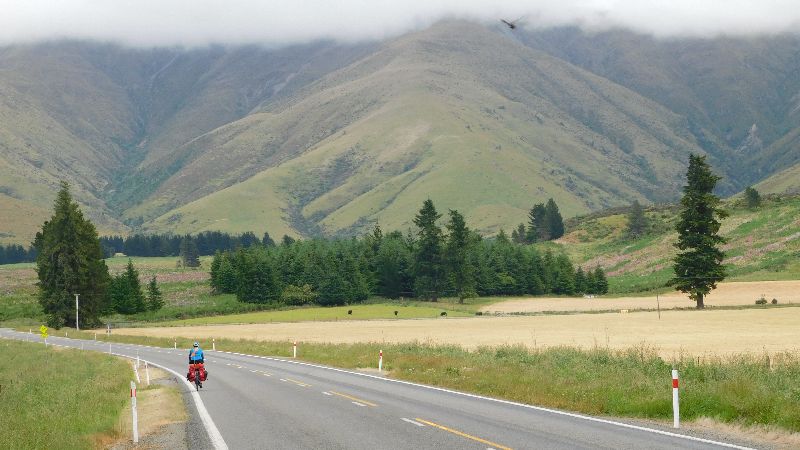
Thankfully, the wind changed direction as we pedaled through Geraldine, a historic sheep ranching town, with a cute downtown of wooden Victorian homes and several museums depicting settler life in the mid-1800s. In high spirits, with the wind at our backs, we began the slow two day climb up to 2326′ Burkes Pass– the first of several major mountain passes on our route around the Alps. We laughed and chatted as we pedaled uphill, following a picturesque, winding road along green, rolling hills, speckled with sheep and cows.
Frustratingly, the mountains ahead of us remained shrouded in clouds all day. We descended into the campground at Fairlie, shivering in the damp, foggy air. The next morning, as we stopped in the town of Burkes Pass, the sky still hung grey over the brown-green mountain range we had climbed. It was fun to poke around the village’s colorful collection of rusted classic cars and travel memorabilia scattered across an eclectic group of old wooden buildings. But still, I worried, ‘Was this all there was to the Alpine beauty that I had dreamed about for years?’
As the road rose steeply out of town, we quickly realized our mistake. The real pass was still ahead! Heads down and toes clicked into the pedals, we pushed slowly upwards for the next hour. Suddenly, without warning, we whizzed over the top of the pass. I gasped. Steep snow capped, hazy blue mountains spread across the horizon as far as the eye could see. It was so much more beautiful than I could have ever imagined. We had finally made it to the Alps!



For the next few hours, we almost floated in a dream above the quiet gravel cycle path that led down to sparkling, glacier-fed Lake Tekapo. The white capped line of mountains ahead slowly loomed larger as we whizzed past fields of waving purple lupins and along babbling brooks streaming on their way to the almost surreal turquoise lake below, nestled in a deep gorge of rolling azure-brown mountain slopes.
That night, we shared our lupin-filled campsite overlooking the brilliant blue lake with a cheerful Italian cyclist, Guiseppe, who was cycling—naturalmente–with his own special backpacking espresso maker! In the coming weeks, as Lorenz and I cycled around and over the awe-inspiring Alps, we would set up our tent each night next to other intrepid cyclists who had also come to pedal New Zealand from around the world—from Germany, France, Italy, the Netherlands, Australia, Japan, and the U.S.
From Lake Tekapo, we turned south and east onto the popular Alps to Ocean (A2O) gravel bike trail —one of the most famous of New Zealand’s Great Rides network (see www.newzealand.com/us/cycling or download the Great Rides app). For the next few days, we stopped frequently to take photos of the jaw-dropping scenes of glacier-covered 12,218′ Mount Cook towering over a string of deep turquoise lakes and rushing silt-filled glacial rivers, sharing our joy with the occasional excited cyclist headed down the trail to the Pacific Ocean.
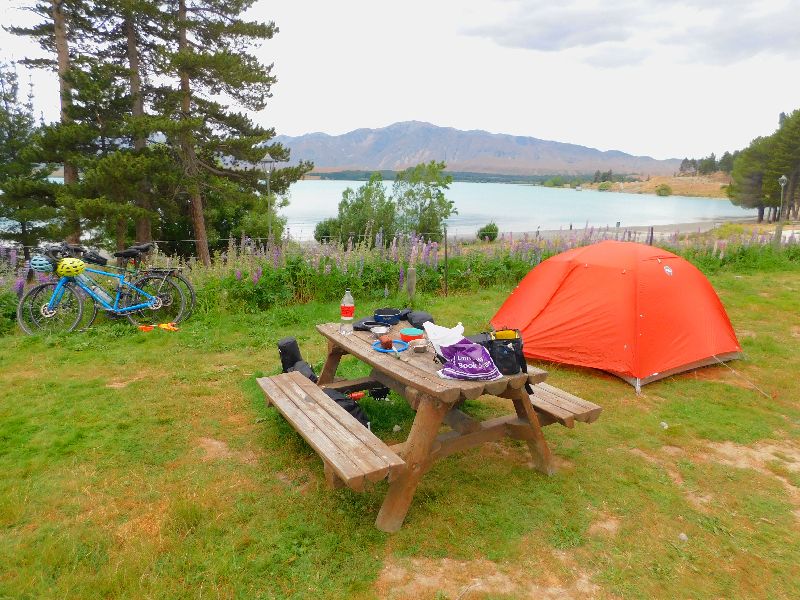
For a moment, we debated whether we should keep pedaling east with the flow of downhill A2O bike tourists —ranging from independent cyclists to fully supported touring groups. It was truly tempting to follow this easy, quiet, downhill, scenic grade to the ocean. But we were determined to cycle into the heart of the Alps. And that required pedaling through the wild, empty Otago high plains region and over Lindis Pass before heading towards Wanaka and the west coast. And so, at Omarama, we turned southwest towards the dry, barren Barrier Range, stopping to stock up with pounds of pasta, granola, crackers and sausage at the last supermarket we would see until Wanaka, 116 kilometers away.
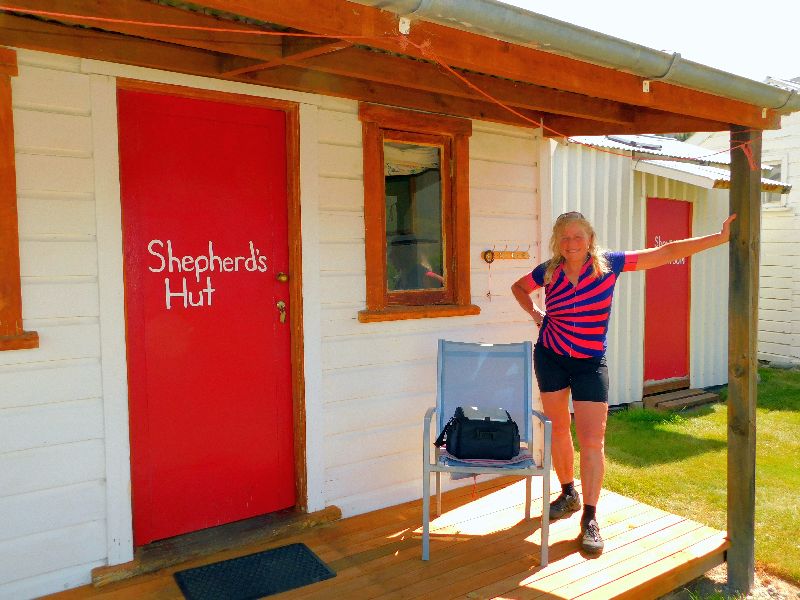
New Zealand is famous for its sheepherding ranches. If you are lucky you might be able to stay in one of their rudimentary huts built for shepherds in the early 1900s and converted for adventurous guests
We spent the night in a converted 1920’s wooden shepherd’s cabin at the remote Dunstan Downs sheep ranch. “Hooray for hot water!” I sighed with relief in the communal showers, as I washed off the sweat and dust from the long, hot, gradual uphill ride through the arid, brown-green tussock grasslands of the Otago plains. Gasping in the frigid air, I buttoned up my puffy down vest as I walked outside to gaze at the strange stars sparkling in the clear southern hemisphere night sky. It was hard to believe that just a few hours earlier, we had been sweating under the blistering sun of the arid, empty grasslands of the Otago plains.
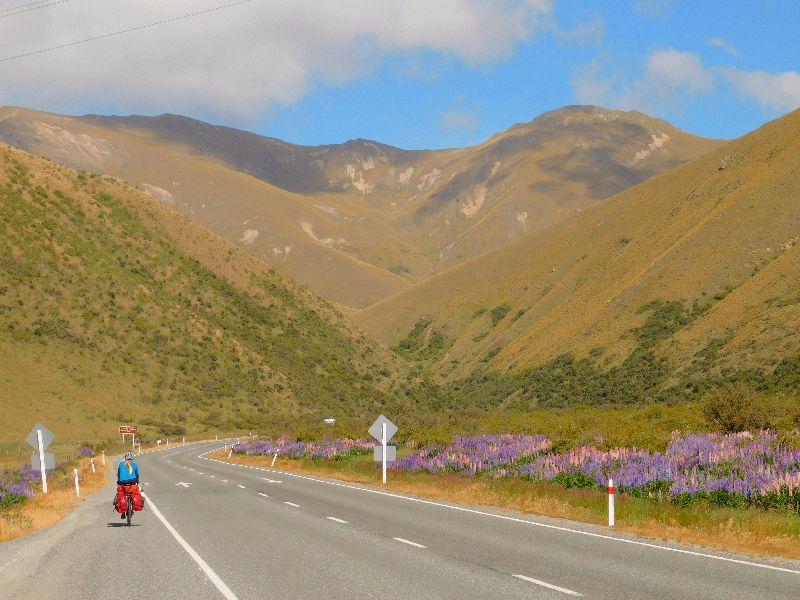
The climb over 3186′ Lindis Pass was surprisingly lovely. We pedaled higher and higher in the cool morning air into stark, brown-green, rolling mountains, the road lined with purple lupins. We whizzed down the other side of the pass, thinking that the hardest part of the ride was behind us. Of course not! As we pedaled up and down seemingly endless hills with tired legs, the remaining 80 kilometer route ahead to Wanaka felt brutal. With nowhere to camp along the desolate road (wild camping is forbidden in New Zealand), we turned on a dirt road and knocked on the door of a sheep ranch. We were in luck! They sent us to a ‘neighbor’ a couple of miles away, who put us up in their newly converted shepherd’s hut for the night.
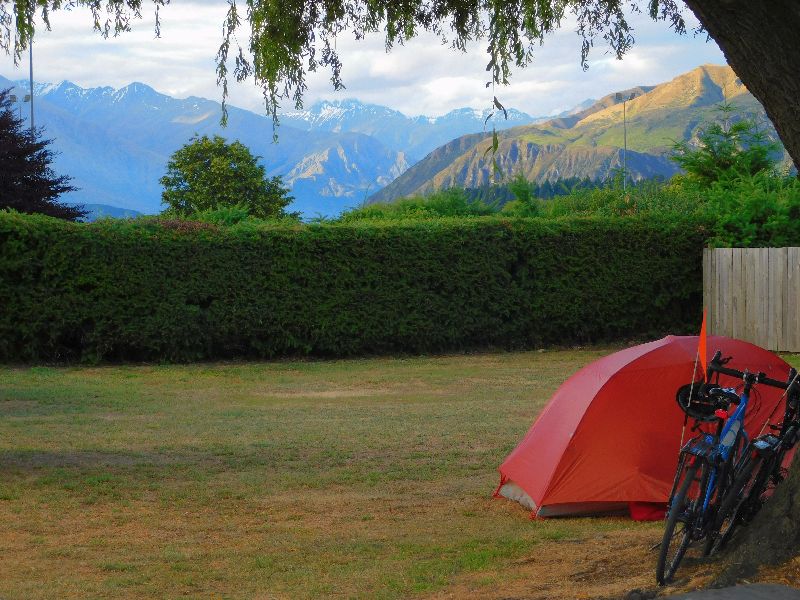
The next day, we feasted on home cooked mutton pies and scones with clotted cream at the popular Tarras café, before finally crossing the historic red bridge over the Clutha River, and whizzing past yet another airplane museum, to drop into the seemingly thriving metropolis of 12,150 people in Wanaka. After almost two weeks of cycling through tiny towns and desolate high mountain landscapes, we were overjoyed to land in this lovely, bustling tourist town, set along beautiful Lake Wanaka, its deep waters winding up a green, wooded valley, with snow capped mountains looming in the distance. ‘No wonder so many cyclists told us they love this town,’ I mused as we sat at a café along the waterfront, sipping coffee in the sun. I gazed across the water to the mountains in the distance, wondering what great new adventures still lay ahead for us along the west coast route.
many cyclists told us they love this town,’ I mused as we sat at a café along the waterfront, sipping coffee in the sun. I gazed across the water to the mountains in the distance, wondering what great new adventures still lay ahead for us along the west coast route.
To read the rest of our adventures cycling the southern Alps circuit, got to “Cycling New Zealand’s wild west coast“
The Great Rides Network is a great resource for planning a cycling tour in New Zealand.
Want more great cycling adventures, photos and stories or have questions about a trip you want to take? Email us at info@bike4breath.com. Follow us on Instagram @bike4breath or sign up for our blog at https://bike4breath.com/contact-us/. You might also love reading our book, Breathtaking: How one family cycled around the world for clean air and asthma about our family’s cycling adventures around the world–through 24 countries across Europe, Asia, the South Pacific and North America.


you guys are so inspiring!
Thanks Stuart for your unfailing support of us.